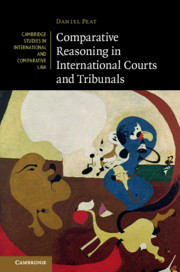Book contents
- Comparative Reasoning in International Courts and Tribunals
- Cambridge Studies in International and Comparative Law: 145
- Comparative Reasoning in International Courts and Tribunals
- Copyright page
- Contents
- Foreword
- Preface
- Table of Cases
- Table of Treaties
- Abbreviations
- 1 Introduction
- 2 The Limits of the Vienna Convention
- 3 Domestic Law in the Jurisprudence of the International Court of Justice
- 4 The Interpretation of Schedules of Commitments in the WTO
- 5 International Investment Law and the Public Law Analogy
- 6 Consensus Doctrine in the European Court of Human Rights
- 7 Domestic Law and System Building in the ICTY
- 8 Conclusion
- Bibliography
- Index
- Cambridge Studies in International and Comparative Law
8 - Conclusion
Published online by Cambridge University Press: 24 May 2019
- Comparative Reasoning in International Courts and Tribunals
- Cambridge Studies in International and Comparative Law: 145
- Comparative Reasoning in International Courts and Tribunals
- Copyright page
- Contents
- Foreword
- Preface
- Table of Cases
- Table of Treaties
- Abbreviations
- 1 Introduction
- 2 The Limits of the Vienna Convention
- 3 Domestic Law in the Jurisprudence of the International Court of Justice
- 4 The Interpretation of Schedules of Commitments in the WTO
- 5 International Investment Law and the Public Law Analogy
- 6 Consensus Doctrine in the European Court of Human Rights
- 7 Domestic Law and System Building in the ICTY
- 8 Conclusion
- Bibliography
- Index
- Cambridge Studies in International and Comparative Law
Summary
The preceding chapters demonstrate that domestic law has been used by international courts and tribunals in a variety of different ways to interpret international legal rules or instruments. Each instance of comparative reasoning is inextricably linked to the legal and historical context in which it occurs and in which the court or tribunal operates. The novelty of the specific legal regime, the presumed knowledge of other states parties or the presence of nebulous treaty standards are all factors that have led to the use of domestic law as a means of interpretation. As such, drawing general conclusions from a study such as this is difficult.
- Type
- Chapter
- Information
- Comparative Reasoning in International Courts and Tribunals , pp. 214 - 221Publisher: Cambridge University PressPrint publication year: 2019

